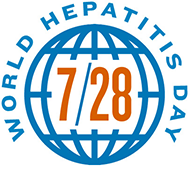Resources for World Hepatitis Day

World Hepatitis Day is July 28th
World Hepatitis Day is recognized annually on July 28th, the birthday of Dr. Baruch Blumberg (1925-2011). Dr. Blumberg discovered the hepatitis B virus in 1967 and two years later developed the first hepatitis B vaccine and for these achievements won the Nobel Prize.
Viral hepatitis is caused by infection of one of five viruses – hepatitis A, B, C, D or E. All hepatitis viruses can cause inflammation of the liver, and chronic hepatitis B and C can lead to cirrhosis and liver cancer. According to the 2017 World Health Organization (WHO) Global hepatitis report, 2017, viral hepatitis is a major global health threat with around 257 million people living with chronic hepatitis B and 71 million people living with chronic hepatitis C.
In order to raise awareness of this hidden epidemic, July 28th has been designated as World Hepatitis Day. Organizations around the world, including WHO and CDC, use World Hepatitis Day to raise awareness of the problem and what needs to be done to strengthen efforts in prevention, screening and control of viral hepatitis. This year’s World Hepatitis Day theme is “Eliminate Hepatitis”.
Viral Hepatitis: A Global Perspective
Worldwide, viral hepatitis is among the top 10 infectious disease killers with more than 1.344 million people dying each year from chronic viral hepatitis. These deaths are primarily from cirrhosis or liver cancer caused by hepatitis B and hepatitis C. In fact, chronic hepatitis B and chronic hepatitis C cause approximately 60% of liver cancer cases.
Many of those who are chronically infected are unaware of their infection. People can live with chronic viral hepatitis for decades before having symptoms or feeling sick. So even though a person has no symptoms and may appear healthy, damage to their liver can still be occurring.
The good news is hepatitis A and hepatitis B can be prevented with safe, effective vaccine. Over the last several decades in the U.S., there has been more than a 90% decrease in hepatitis A cases, and many experts believe this decline is due to vaccination of children and people at risk for hepatitis A. In many parts of the world, widespread infant vaccination programs have led to a decrease in new cases of hepatitis B. There is currently no vaccine to prevent hepatitis C, but research is ongoing.
Treatments for hepatitis B are available that can delay or even prevent liver damage, cirrhosis and liver cancer. Treatments are available for hepatitis C that can cure the disease. In fact, over 95% of people with hepatitis C can be completely cured within 2-3 months.
Hepatitis Risk Assessment
Share this 5 minute online assessment developed by the CDC which allows individuals to answer a series of questions and provides a personalized and tailored report of hepatitis testing and vaccination recommendations.
Hepatitis Risk Assessment buttons/badges are available to share the assessment with others.
“World Hepatitis Day” image
Please feel free to right-mouse-click on this image link and save to use on your own webpage or in your email signature block.
Stay Connected
Follow CDC Viral Hepatitis on Twitter @CDChep for information on all types of viral hepatitis. Join the conversation and help us spread the word by using the #WorldHepDay, #EliminateHepatitis, and #NOhep. Also, sign up to get viral hepatitis email updates from CDC through GovDelivery.
More Information
- Page last reviewed: July 7, 2017
- Page last updated: July 7, 2017
- Content source:


 ShareCompartir
ShareCompartir